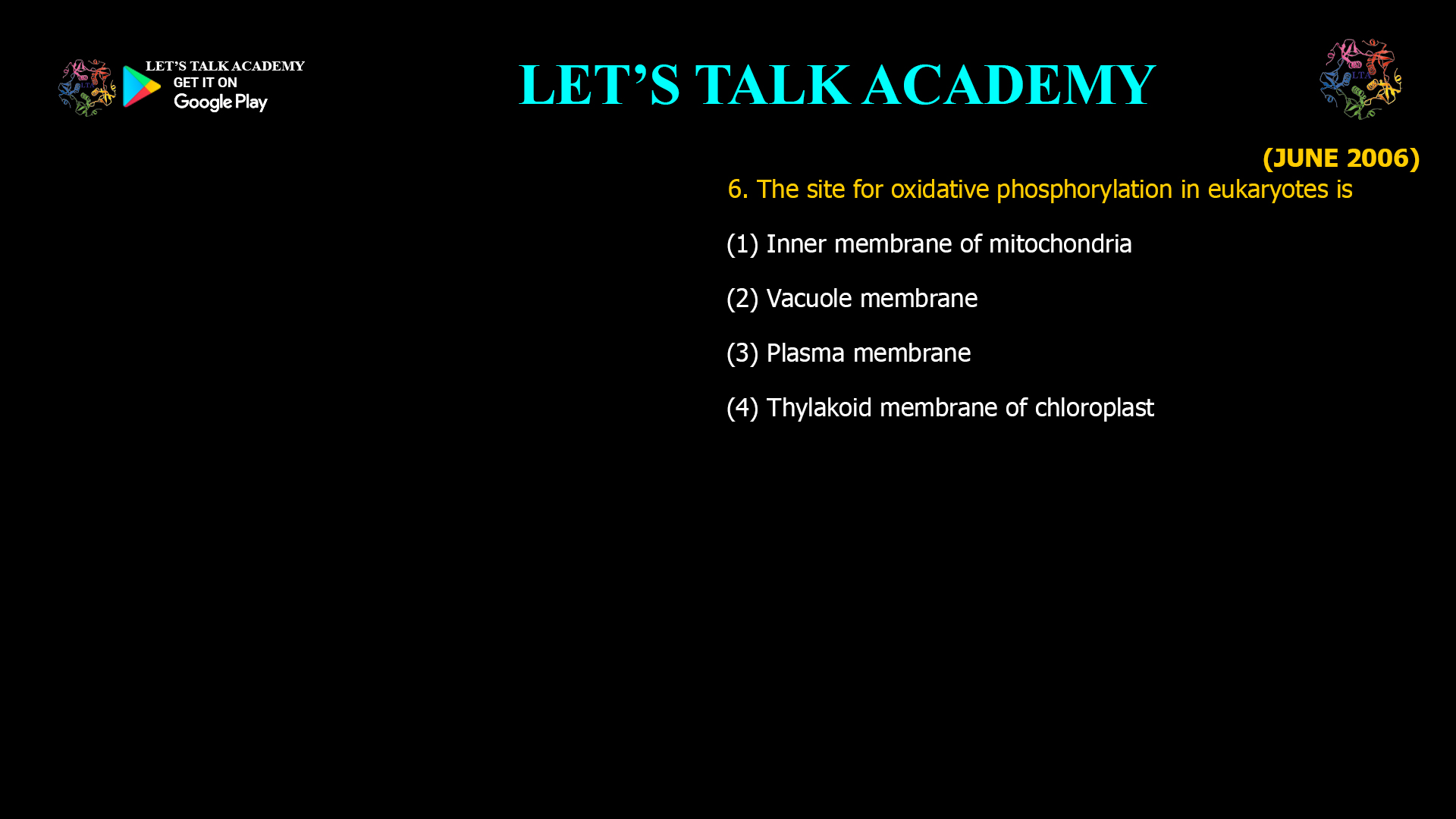6. The site for oxidative phosphorylation in eukaryotes is
(1) Inner membrane of mitochondria
(2) Vacuole membrane
(3) Plasma membrane
(4) Thylakoid membrane of chloroplast
Oxidative phosphorylation is a critical biochemical process that powers nearly all aerobic life forms by producing the majority of cellular ATP, the energy currency of the cell. In eukaryotic organisms, this process takes place in a specialized organelle known as the mitochondrion. More specifically, the site of oxidative phosphorylation is the inner membrane of mitochondria.
This article delves into the structure and function of the mitochondrial inner membrane and explains why it is the essential site for oxidative phosphorylation in eukaryotic cells.
What Is Oxidative Phosphorylation?
Oxidative phosphorylation is the final stage of cellular respiration, where energy stored in reduced electron carriers (NADH and FADH2) is converted into ATP. This energy conversion involves two tightly coupled processes:
-
Electron Transport Chain (ETC): A series of protein complexes and mobile carriers embedded in the mitochondrial inner membrane transfer electrons from NADH and FADH2 to molecular oxygen.
-
Chemiosmosis: The energy released during electron transport pumps protons (H⁺ ions) across the inner membrane, creating an electrochemical gradient. ATP synthase then uses this proton motive force to synthesize ATP from ADP and inorganic phosphate.
Why the Inner Mitochondrial Membrane?
The mitochondrion has a unique double-membrane structure:
-
Outer membrane: Permeable to small molecules and ions, serving mainly as a protective barrier.
-
Inner membrane: Highly impermeable and folded into cristae, greatly increasing its surface area.
The inner membrane is the exclusive site where the electron transport chain complexes (Complexes I-IV) and ATP synthase reside. This membrane’s impermeability to protons is crucial for establishing and maintaining the proton gradient necessary for ATP production.
Key Features of the Inner Mitochondrial Membrane
-
Electron Transport Complexes: Four main complexes (I-IV) facilitate electron transfer and proton pumping.
-
ATP Synthase: A large enzyme complex that harnesses the proton gradient to generate ATP.
-
Cristae: Foldings that increase surface area, allowing more space for these protein complexes and enhancing ATP production capacity.
-
Selective Permeability: Maintains the proton gradient by preventing free diffusion of protons back into the matrix.
The Process in Detail
-
Electron Donation: NADH and FADH2 donate electrons to the ETC at Complex I and II, respectively.
-
Electron Transfer: Electrons pass through complexes III and IV, releasing energy.
-
Proton Pumping: Energy from electron transfer pumps protons from the mitochondrial matrix into the intermembrane space, creating a proton gradient.
-
Oxygen Reduction: At Complex IV, electrons combine with oxygen and protons to form water, the terminal electron acceptor step.
-
ATP Synthesis: Protons flow back into the matrix through ATP synthase, driving ATP production.
Why Other Membranes Are Not the Site
-
Vacuole membrane: Vacuoles are storage organelles and do not participate in ATP synthesis.
-
Plasma membrane: In prokaryotes, the plasma membrane performs respiration, but in eukaryotes, this function is localized to mitochondria.
-
Thylakoid membrane of chloroplast: Site of photophosphorylation during photosynthesis, not oxidative phosphorylation.
Significance of Oxidative Phosphorylation in the Inner Membrane
-
It is the most efficient way to produce ATP, yielding approximately 30-34 ATP molecules per glucose molecule.
-
The inner membrane’s structure and protein composition are optimized for energy conversion.
-
Dysfunction in this membrane or its complexes can lead to metabolic diseases and aging.
Summary Table
| Option | Correctness | Reason |
|---|---|---|
| (1) Inner membrane of mitochondria | Correct | Contains ETC and ATP synthase; site of oxidative phosphorylation |
| (2) Vacuole membrane | Incorrect | Not involved in respiration or ATP synthesis |
| (3) Plasma membrane | Incorrect for eukaryotes | Site of respiration in prokaryotes, not eukaryotes |
| (4) Thylakoid membrane of chloroplast | Incorrect | Site of photophosphorylation, not oxidative phosphorylation |
Conclusion
The inner membrane of mitochondria is the definitive site for oxidative phosphorylation in eukaryotic cells. Its specialized structure and embedded protein complexes enable efficient electron transport, proton pumping, and ATP synthesis, powering cellular activities vital for life.
By understanding the role of the mitochondrial inner membrane in oxidative phosphorylation, researchers and students gain insights into cellular energy metabolism, mitochondrial diseases, and bioenergetics.
This knowledge is foundational for fields ranging from cell biology and physiology to medicine and bioengineering, highlighting the central role of mitochondria in eukaryotic life.




7 Comments
Pallavi Ghangas
September 23, 2025inner membrane of mitochondria
Kirti Agarwal
September 24, 2025Inner membrane of mitochondria
Roopal Sharma
September 25, 2025Inner membrane of mitochondria
Heena Mahlawat
September 25, 2025Inner membrane of mitochondria
Minal Sethi
September 25, 2025Inner membrane of mitochondria
Manisha choudhary
September 26, 2025Oxydative phosphorylation, eukaryotes m inner membrane of mitrochondria m hoti h
Outer membrane of mitrochondria ions small molecules k liye permeable hoti h , protective barrier ki tarah kaam krti h mainly
Inner mitrochondrial membrane selective permeable hoti h
Prokaryotes m plasma membrane m hota h respiratory
Chloroplast ki thylakoid membrane m photophosphorylation hota h
Kajal
October 5, 2025Mitochondria inner membrane